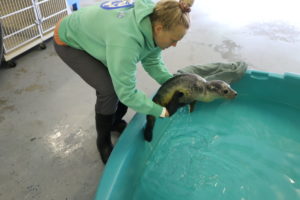by Brianna Blunck
 This February, I enthusiastically accepted the position as MMoME’s first veterinary preceptor, excited for a new experience and to apply what I’ve learned in school thus far.
This February, I enthusiastically accepted the position as MMoME’s first veterinary preceptor, excited for a new experience and to apply what I’ve learned in school thus far.
I had previously worked as a veterinary technician in an emergency hospital and as a volunteer for a wildlife rehabilitation facility in Hunter, New York, caring mostly for woodland animals. But nothing quite prepares you for pupping season at MMoME!
It’s been a quick learning curve as I’ve adjusted to handling new species; even blood draws and IV placement are so different. But seeing our patients grow stronger and more independent throughout this summer makes all the hard work worth it.
Both my master’s program and MMoME promote similar messages of interdisciplinary collaboration to address issues of human-animal interactions and conservation. And while a day at MMoME doesn’t always incorporate the clinical skills I use in a veterinary hospital, I have been able to apply the knowledge I’ve drawn from many of my classes both at PennVet and Tufts.
My immunology and disease surveillance classes provided a great foundation for looking at viral titers measured in blood samples collected from our patients. MMoME screens for one particular infectious disease, the phocine distemper virus, which was the cause of the harbor seal unusual mortality event in 2018.
Because tests like these must be sent to outside labs, which can be costly, we test only high priority animals. We keep a keen eye on our in-house bloodwork values and note how animals are feeling and behaving before running the test. Additional diagnostics are always beneficial, painting a fuller picture and the ability to learn more for ourselves and to educate others.
Because of the COVID-19 pandemic, this last year the majority of my classes were remote and I didn’t get to have as many in-person hours at the anatomy lab, where I would have learned more about the ins and outs of dogs and other large animals.
But while some parts of seals’ anatomy differ from dogs’, seals are the “dogs of the sea” and the fundamentals are the same. Working with MMoME’s knowledgeable staff, and performing necropsies in particular, has helped supplement what I’ve learned in anatomy so far, and has even been more hands-on. The recent donation of a microscope from a generous donor has also allowed me to practice blood smears using a real microscope, which I didn’t have the opportunity to do during my virtual histopathology class this past year.
In a few weeks, we’re expecting to release five patients! This is a wonderful testament to the care and hard work we have dedicated to rehabilitating the harbor seal population of Maine. It’s been such a privilege to work side by side with MMoME’s Executive Director Lynda Doughty and our veterinarian, Dr. Temm, and I’m honored to have been included in conversations about treatment plans, and (on a more difficult note) end-of-life decisions.
I am so thankful for the fun, rewarding, and educational summer I’ve had, courtesy of the MMoME team!
Brianna Blunck is a veterinary student at the University of Pennsylvania School of Veterinary Medicine in Philadelphia and has an M.S. in Conservation Medicine from Tufts University.

